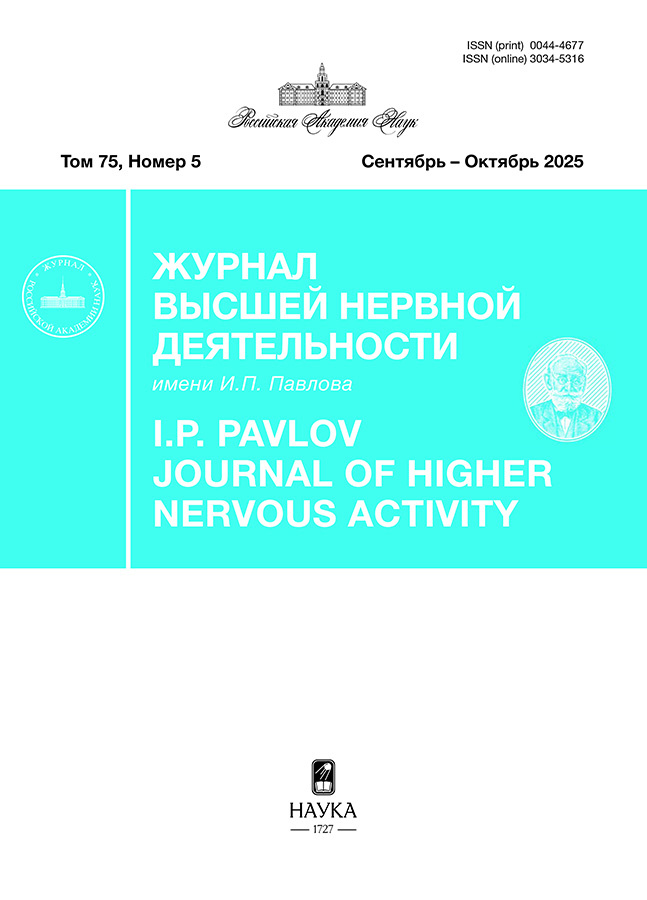Participation of astroglia in morphological and functional integration of neurotransplants with the recipient’s brain
- 作者: Zhuravleva Z.N.1
-
隶属关系:
- Laboratory of Systemic Neuronal Organization, Institute of Theoretical and Experimental Biophysics RAS, Pushchino, Moscow Region, Russia
- 期: 卷 75, 编号 5 (2025)
- 页面: 612-620
- 栏目: ФИЗИОЛОГИЧЕСКИЕ МЕХАНИЗМЫ ПОВЕДЕНИЯ ЖИВОТНЫХ: ВОСПРИЯТИЕ ВНЕШНИХ СТИМУЛОВ, ДВИГАТЕЛЬНАЯ АКТИВНОСТЬ, ОБУЧЕНИЕ И ПАМЯТЬ
- URL: https://rjonco.com/0044-4677/article/view/692569
- DOI: https://doi.org/10.31857/S0044467725050092
- ID: 692569
如何引用文章
详细
Histological and electron microscopic studies of dentate fascia neurotransplants in the somatosensory region of the rat neocortex were performed. It was shown that mature nerve tissue developed in the transplants with reproduction of the organotypic characteristics of differentiated neurons and glial cells. Particular attention was paid to the study of the cellular organization of the boundary between the transplanted and neocortical tissues (interface) as well as the possibility of neuronal processes growing through it. The leading role in the integrative process belonged to different subpopulations of astrocytes. Mature protoplasmic and fibrous astrocytes, as well as astrocytic precursors, and ependymal cells were identified at different sites of the interface. The cellular composition of the border influenced the degree of integration of the transplants with the adjacent brain, ranging from maximum integration in the astrocytic type of border to limited exchange of axonal and dendritic processes in the ependymal type. Fibrous astrocyte processes accompanied and guided bundles of axons and dendrites through interface. The only barrier to the growing nerve processes were the interface regions, into which large blood vessels penetrated from the pia mater.
作者简介
Z. Zhuravleva
Laboratory of Systemic Neuronal Organization, Institute of Theoretical and Experimental Biophysics RAS, Pushchino, Moscow Region, Russia
编辑信件的主要联系方式.
Email: zina_zhur@mail.ru
Pushchino, Moscow Region, Russia
参考
- Александрова М.А., Сухинич К.К. Астроциты мозга – свита делает короля. Онтогенез. 2022. 53 (4): 265–286.
- Журавлева З.Н. Гиппокамп и нейротрансплантация. Журн. высш. нервн. деят. им. И.П. Павлова. 2004. 54 (2): 149–162.
- Журавлева З.Н. Синаптические контакты нейронов трансплантатов зубчатой фасции с неспецифическими мишенями в неокортексе реципиентов. Онтогенез. 2002. 33 (3): 230–235.
- Лосева Е.В., Подгорный О.В., Полтавцева Р.А., Марей М.В., Логинова Н.А., Курская О.В., Сухих Г.Т., Чайлахян Р.К., Александрова М.А. Эффекты нейротрансплантации культивируемых нейральных и мезенхимальных стволовых клеток человека на обучение и состояние мозга крыс после гипоксии. Рос. физиол. журн. им. И.М. Сеченова. 2011. 97 (2): 155–168.
- Сухинич К.К., Шакирова К.М., Дашинимаев Э.Б., Александрова М.А. Развитие 3D церебральных агрегатов в желудочках мозга взрослых мышей. Онтогенез. 2021. 52 (3): 195–207.
- Blackstad T.W., Kjaerheim A. Special axo-dendritic synapses in the hippocampal cortex: electron and light microscopic studies on the layer of mossy fibers. J. Comp. Neurol. 1961. 117 (2): 133–159.
- Boghdadi A.G., Teo L., Bourne J.A. The neuroprotective role of reactive astrocytes after central nervous system injury. J. Neurotraum. 2020. 37: 681–691.
- Bragin A., Takács J., Vinogradova O., Zhuravleva Z.N., Hamori J. Number of GABA-immunopositive and GABA-immunonegative neurons in various types of neocortical transplants. Exp. Brain Res. 1991. 85 (1): 114–128. https://doi.org/10.1007/BF00229992
- Dias D.O., Göritz C. Fibrotic scarring following lesions to the central nervous system. Matrix Biol. 2018. 68–69: 561–570. https://doi.org/10.1016/j.matbio.2018.02. 009
- Escartin C., Galea E., Lakatos A. O’Callaghan J.P., Petzold G.C., SerranoPozo A. et al. Reactive astrocyte nomenclature, definitions, and future directions. Nat. Neurosci. 2021. 24: 312–325. https://doi.org/10.1038/s41593-020-00783-4
- Fitch M.T., Silver J. CNS injury, glial scars, and inflammation: Inhibitory extracellular matrices and regeneration failure. Exp. Neurol. 2008. 209: 294–301.
- Gage F.H. Neurogenesis in the adult brain. J. Neurosci. 2002. 22 (3): 612–613. https://doi.org/10.1523/JNEUROSCI.22-03-00612.2002
- Groh A.M.R., Song Y.L., Tea F., Lu B., Huynh S., Afanasiev E. et al. Multiciliated ependymal cells: an update on biology and pathology in the adult brain. Acta Neuropathol. 2024. 148 (1): 39. https://doi.org/10.1007/s00401-024-02784-0.
- Hamlyn L.H. The fine structure of the mossy fibre endings in the hippocampus of the rabbit. J. Anat. (Lond.) 1962. 96 (1): 112–120.
- Han Q., Xie Y., Ordaz J.D., Huh A.J., Huang N., Wu W. et al. Restoring cellular energetics promotes axonal regeneration and functional recovery after spinal cord injury. Cell Metab. 2020. 31: 623–641.e8. https://doi.org/10.1016/j. cmet.2020.02.002
- Hart C.G., Karimi-Abdolrezaee S. Recent insights on astrocyte mechanisms in CNS homeostasis, pathology, and repair. J. Neurosci. Res. 2021. 99 (10): 2427–2462. https://doi.org/10.1002/jnr.24922
- Kumar A., Fontana I.C., Nordberg A. Reactive astrogliosis: A friend or foe in the pathogenesis of Alzheimer’s disease. J. Neurochem. 2023. 164 (3): 309–324. https://doi.org/10.1111/jnc.15565
- Ma S., Kwon H.J., Huang Z. A functional requirement for astroglia in promoting blood vessel development in the early postnatal brain. PLoS ONE. 2012. 7 (10): e48001. https://doi.org/10.1371/journal.pone.0048001
- Park T.-Y., Jeon J., Cha Y., Kim K.-S. Past, present, and future of cell replacement therapy for parkinson’s disease: a novel emphasis on host immune responses. Cell Res. 2024. 34 (7): 479–492.
- Pavlou M.A.S., Grandbarbe L., Buckley N.J., Niclou S.P., Michelucci A. Transcriptional and epigenetic mechanisms underlying astrocyte identity. Prog. Neurobiol. 2019. 174: 36–52. https://doi.org/10.1016/j.pneurobio.2018.12.007
- Rao K.V., Panickar K.S., Jayakumar A.R. et al. Astrocytes protect neurons from ammonia toxicity. Neurochem. Res. 2005. 30: 1311–1318.
- Šimončičová E., Henderson Pekarik K., Vecchiarelli H.A., Lauro C., Maggi L., Tremblay M.È. Adult neurogenesis, learning and memory. Adv. Neurobiol. 2024. 37: 221–242. https://doi.org/10.1007/978-3-031-55529-9_13
- Temple S. Advancing cell therapy for neurodegenerative diseases. Cell Stem Cell. 2023. 30 (5): 512–529. https://doi.org/10.1016/j.stem.2023.03.017
- Villarreal A., Vogel T. Different Flavors of Astrocytes: Revising the origins of astrocyte diversity and epigenetic signatures to understand heterogeneity after injury. Int. J. Mol. Sci. 2021. 22 (13): 6867. https://doi.org/10.3390/ijms22136867
- Zaqout S., Kaindl A.M. Golgi-Cox staining step by step. Front. Neuroanat. 2016. 10: Article 38. https://doi.org/10.3389/fnana.2016.00038
- Zhang Y., Li B., Cananzi S., Han C., Wang L.L., Zou Y. et al. A single factor elicits multilineage reprogramming of astrocytes in the adult mouse striatum. Proc. Natl. Acad. Sci. USA. 2022. 119 (11): e2107339119. https://doi.org/10.1073/pnas.2107339119
补充文件









